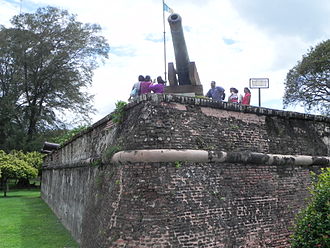Penang

Penang is a Malaysian state located on the northwest coast of Peninsular Malaysia, by the Malacca Strait. It has two parts: Penang Island, where the capital city, George Town, is located, and Seberang Perai on the Malay Peninsula. They are connected by Malaysia’s two longest road bridges, the Penang Bridge and the Sultan Abdul Halim Muadzam Shah Bridge; the latter is also, as of May 2019, the longest oversea bridge in Southeast Asia.[4] The second smallest Malaysian state by land mass, Penang is bordered by Kedah to the north and the east, and Perak to the south.[1]
Penang’s population stood at nearly 1.767 million as of 2018, while its population density rose to 1,684/km2 (4,360/sq mi).[2] It has among the nation’s highest population densities and is one of the country’s most urbanised states.[5] Seberang Perai is Malaysia’s second-largest city by population.[6] Its heterogeneous population is highly diverse in ethnicity, culture, language and religion. Aside from the three main races, the Malays, Chinese, and Indians, Penang is home to significant Eurasian, Siamese and expatriate communities.[7][8][9] George Town is also home to a UNESCO World Heritage Site. A resident of Penang is colloquially known as a Penangite or Penang Lang (Penang Hokkien: 庇能儂; Tâi-lô: Pī-néeng-lâng) in Penang Hokkien.[10]
Penang’s modern history began in 1786, upon the establishment of George Town by Francis Light. Penang formed part of the Straits Settlements in 1826, which became a British crown colony in 1867. Direct British rule was only briefly interrupted during World War II, when Japan occupied Penang; the British retook Penang in 1945. Penang was later merged with the Federation of Malaya (now Malaysia), which gained independence from the British in 1957. Following the decline of its entrepôt trade towards the 1970s, Penang’s economy was reoriented towards hi-tech manufacturing.[11]
Known as the Silicon Valley of the East for its industries, Penang is one of Malaysia’s most vital economic powerhouses.[12][13][14] Penang has the highest Gross Domestic Product per capita among all Malaysian states and is considered a high-income economy.[15] In addition, Penang recorded the nation’s third highest Human Development Index, after Kuala Lumpur and Selangor.[16] Correspondingly, the state has a relatively well-educated population, with a youth literacy rate of 99.5% as of 2014.[17]
The name Penang comes from the modern Malay name Pulau Pinang which means “areca nut island”.[18] The State of Penang is also referred to as the Pearl of the Orient and “The Island of Pearls” (in Malay: Pulau Mutiara).[19][20]
Penang Island was originally known by native seafarers as Pulau Ka-Satu, meaning The First Island, because it was the largest island encountered on the trading sea-route between Lingga and Kedah.[21] Similarly, the Siamese, then the overlord of Kedah, referred to the island as Koh Maak (Thai: เกาะหมาก).[22][23]
In the 15th century, Penang Island was referred to as Bīnláng Yù[citation needed] (traditional Chinese: 檳榔嶼; simplified Chinese: 槟榔屿; pinyin: bīn láng yǔ; Pe̍h-ōe-jī: Pin-nn̂g-sū) in the navigational drawings used by Admiral Zheng He of Ming China.[24] Emanuel Godinho de Eredia, a 16th-century Portuguese historian, also referred to the island as Pulo Pinaom in the Description of Malacca.[25]
